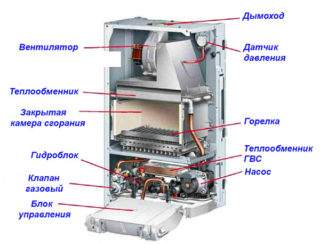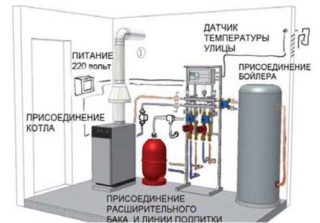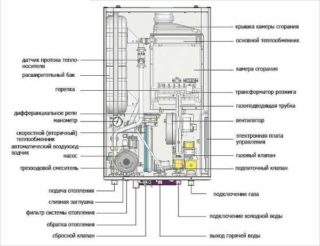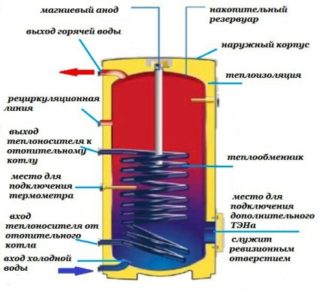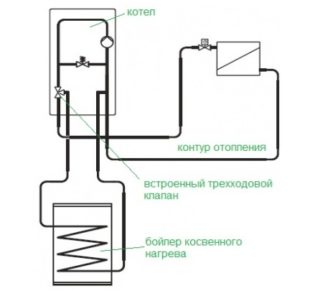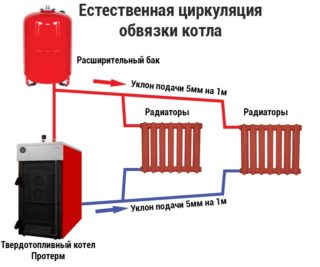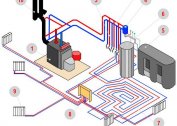The main task of any existing heating system is to create the most comfortable microclimate in a suburban home. Proper organization of the heating sector allows you to evenly distribute the heat flux over the entire heated area, as well as protect equipment components from possible overloads. The functional piping of the solid fuel boiler is the most important part of the procedure for connecting the unit to the heating circuit, made in accordance with current technical standards.
What is strapping for?
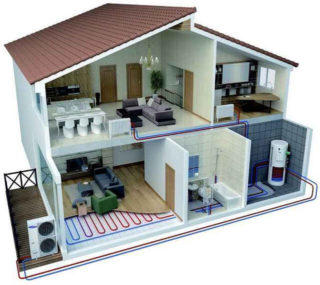
The heating boiler belongs to the class of equipment, the use of which is justified only when a branched network of pipes with a coolant circulating in them is connected to it (piping). From the point of view of the technical means used, the boiler components include the following components:
- steel, aluminum and combination radiators;
- valve control valves;
- coolant condition monitoring devices (pressure and temperature sensors);
- coarse filters;
- safety (buffer) valves and other auxiliary equipment.
An electric pump is also included in this kit - an essential element of any dynamic system.
Tying a heating boiler in a private house is necessary to ensure its functionality in accordance with the main purpose - efficient heating of the surrounding living spaces.
Strapping options
The choice of strapping scheme that is optimal for the system of a given configuration directly depends on the specific design of the purchased boiler equipment sample. By the method of placement within the premises chosen for it and the design of the eyeliner, these units are divided into the following classes:
- standard floor boilers;
- lightweight (compact) wall mounted devices.
The main requirement for the installation of units installed on the floor is to prohibit tapping their working nozzles into the upper section of the pipeline wiring.
In case of violation of this rule when tying the floor boiler in systems that are not equipped with air valves, very dangerous formations (plugs) will appear. To reduce the likelihood of their occurrence in the absence of valves, the pipe into which the boiler crashes should be located strictly vertically and have a special expansion tank in the upper part.
In the lower zone of units of all categories, automatic devices are provided to ensure their reliable connection to the heating main. In contrast to the boiler installed on the floor, its wall-mounted counterparts already have an expansion mechanism that eliminates the formation of plugs. When considering boiler piping schemes for such systems, it must be borne in mind that the advantage of wall models - low weight and not too large dimensions - is also their drawback. This is due to the fact that compact units from DWG, for example, are limited in their energy capabilities. This means that the capacity declared by this manufacturer is enough for heating buildings with an area of not more than 100 square meters. Therefore, these devices are especially popular with owners of urban apartments.
A distinctive feature is the presence of two versions that differ in their configuration.The complete set of equipment includes most of the strapping elements, and incomplete configurations lack some nodes that are bought by the user on their own.
If you plan to install heating systems with natural circulation, some of the auxiliary equipment may not be required at all.
Features piping single-circuit and 2-circuit boilers
The main difference between the existing methods of organizing the binding of heating systems is their energy capabilities. The power of single-circuit boilers, as a rule, is enough only to heat the structure - to warm the batteries. Such a unit does not allow heating water for domestic needs, which the consumer will have to take care of separately. 2-circuit boilers can not only heat the house, but also heat the water necessary for washing dishes or taking a shower.
Principle of operation of a 2-circuit boiler
The design of these units provides a special heat exchange unit (heat accumulator), designed to heat water and having two versions:
- flow-through products with the “DHW primacy” mode;
- units equipped with a built-in boiler.
If you want to take a shower or just wash the dishes, in the first case it is enough to switch to this mode, after which the 2nd DHW circuit will be connected to the boiler. This design is typical for units of domestic and foreign production. The piping of a flow-type double-circuit boiler is optimally suited for houses or city apartments of not too large area (up to 75-86 square meters.), Since not very powerful heat exchangers are built into these units.
Quite another matter is boilers equipped with a storage boiler, in which the tank capacity varies from 160 to 190 liters. They are intended for heating water both in storage and in flow mode.
Even at the production stage, boiler models are equipped with a special heat exchanger in which separately circulating water is heated due to the energy of the heat carrier of the main heating circuit. For their normal operation, the manufacturer provides a special valve that controls the direction of movement of the energy source. The principle of supremacy of the DHW system is as follows:
- when the valve is in the closed position, the coolant heated to a predetermined level circulates through the heating system, heating the living space;
- if one of the residents opens the hot water tap, the boiler stops heating water for heating and continues to heat it in the boiler, while the second heating circuit is inactive;
- after the valve on the pipeline with hot water closes, the system immediately sends the coolant to the batteries.
In two-pipe systems, both circuits never work simultaneously. However, double-tube boilers are able to provide several points of water intake. If a pair of drain taps is available, it is recommended to place the boiler approximately in the middle between them. If only one point is provided, it is set as close as possible to it.
The principle of operation and single-loop strapping device
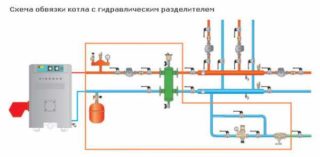 With single-loop boiler strapping, its design has one heat exchanger that heats water only for the heating system. If you want to receive warm liquid for washing dishes from it, you will need to purchase and install an indirect heating boiler nearby. Its main element is a combustion chamber with a gas burner and a coil placed in it, on top of which the heat exchanger is located.
With single-loop boiler strapping, its design has one heat exchanger that heats water only for the heating system. If you want to receive warm liquid for washing dishes from it, you will need to purchase and install an indirect heating boiler nearby. Its main element is a combustion chamber with a gas burner and a coil placed in it, on top of which the heat exchanger is located.
The fluid in the system circulates naturally or a water pump is used for this purpose.
In most single-circuit models, it is possible to connect polypropylene pipes to them from the boiler.After that, the single-tube system begins to function in a 2-circuit mode while observing the principle of priority.
Advantages and disadvantages of a single-circuit boiler
The one-tube version of the organization of the strapping of TT boilers has the following advantages:
- relatively low cost;
- low costs for the purchase, installation and maintenance of the system;
- sufficient power for heating and high efficiency.
Most single-circuit models are available in the floor version, which allows the use of cast-iron heat exchangers. Due to this, the efficiency of the coolant increases, which means the permissibility of heating with their help significant areas (more than 100 sq.m.).
Systems with cast-iron heat exchangers are often used in old-type heating equipment (with gas boilers). A single-loop piping of a gas boiler in this case is preferable due to a decrease in the total energy consumption. However, this statement is not always true. With the arrangement of the strapping of wall-mounted double-circuit gas boilers, supplemented by a boiler for domestic needs, fuel costs will increase.
Harness and type of circulation
The choice of strapping type largely depends on the method of circulation of warm fluid through the pipes and batteries of the loop system. There are two of them - natural displacement and forced.
Natural coolant circulation
With the option of circulating the energy carrier, called natural, the binding of a solid fuel heating boiler in private houses provides for the mandatory use of a closed expansion tank. It is recommended to place it on the "return" at its lowest point and fill it with water by about 10% of the working volume. The structure of such a scheme includes the following elements:
- the pellet heating boiler itself, for example;
- inlet and outlet fittings;
- heating radiators;
- direct and return pipelines;
- typical membrane type expander.
The safety elements of natural circulation systems include a safety valve installed in them, connected to the drain hole through a rubber hose. Its main purpose is to relieve excess pressure when moving the coolant through the boiler pipes of the boiler. In addition, it is customary to refer to them special measuring devices - manometers, with the help of which it is possible to visually assess the pressure in the system.
Sometimes it is not necessary to install these elements separately, since they are already included in the package of the selected type of boiler.
The latter option is possible when purchasing wall models in the appropriate design.
Forced Circulation Harness
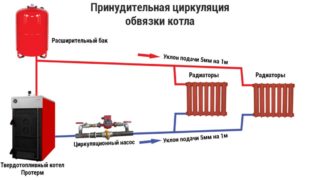 This option for arranging the harness is not significantly different from a closed system with natural coolant circulation. But one additional element appears in it - an electric pump. As a rule, it is installed in the return branch of the pipeline immediately after the membrane tank (in front of the inlet fitting of the heat exchanger).
This option for arranging the harness is not significantly different from a closed system with natural coolant circulation. But one additional element appears in it - an electric pump. As a rule, it is installed in the return branch of the pipeline immediately after the membrane tank (in front of the inlet fitting of the heat exchanger).
The operation of pumping equipment is accompanied by the installation in the heating circuit of a temperature sensor mounted in the return branch.
The presence of an electric pump in the system allows you to flexibly control its operation, since it becomes possible to mount shutoff and control valves on radiators. Thanks to this, the coolant circulating under pressure easily overcomes the most remote and narrow sections of the polypropylene pipeline.
The use of a circulation pump turns the boiler into a system that depends on electrical energy. At the same time, the cost of heating increases, since the cost of maintaining electricity is added to the cost of maintaining an electric boiler.
Collector system
The collector piping of a solid fuel boiler includes approximately the same elements as conventional units. The only exception is the presence in it of a new component called a collector. Plumbers call it a comb, due to the similarity of this node with a female comb. It is made in the form of an extended thick pipe, from which several thin pipes are diverted - one of them is inlet, and the rest are output. Hot water is supplied through the first, which, when flowing through the branch pipe system, is evenly distributed between consumers. At the outlet of the copper collector, all of these flows are reassembled and sent to the "return".
